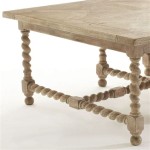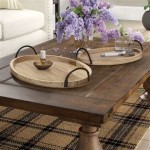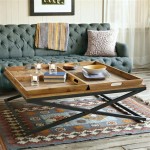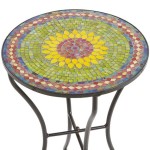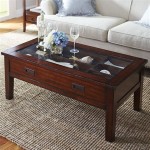How Tall Should A Side Table Be Next To A Chair?
Determining the appropriate height of a side table in relation to an adjacent chair is a crucial aspect of interior design, impacting both the functionality and aesthetics of a living space. A side table that is either too tall or too short can disrupt the flow of movement, make it awkward to reach for items, and ultimately detract from the overall comfort and visual harmony of the room. Therefore, understanding the key considerations and guidelines for side table height selection is essential for creating a well-designed and practical environment.
The primary objective of a side table is to provide a convenient surface for placing drinks, books, remote controls, lamps, or decorative objects within easy reach of someone seated in a chair. The ideal height allows a person to access these items without needing to strain, stretch, or contort their body. This ergonomic principle is the foundation for establishing the appropriate height range.
In general, the height of a side table should be at or slightly below the armrest height of the adjacent chair. This allows for easy placement and retrieval of items without excessive reaching. However, the ideal height can vary depending on several factors, including the specific chair style, the intended use of the side table, and personal preferences. Considering these factors will contribute to a more tailored and effective selection process.
Matching Side Table Height to Chair Armrest Height
The most common and generally accepted guideline is that the side table should be approximately the same height as the chair's armrest or a few inches lower. This relative height allows someone seated in the chair to easily reach the table without having to lean too far forward or reach upwards awkwardly. For example, if a chair has armrests that are 25 inches from the floor, a side table between 23 and 25 inches tall would likely be a suitable choice.
This principle applies to a wide range of chair types, including armchairs, accent chairs, and even some types of sofas, particularly those with lower armrests. However, it's important to measure the actual height of the armrest rather than relying on estimates, as armrest heights can vary considerably between different chair models. Precise measurements are key to ensure optimal comfort and usability.
To accurately determine the armrest height, use a measuring tape to measure from the floor to the top of the armrest. Take this measurement at the point where the armrest is directly adjacent to where someone would typically sit. This provides the most accurate representation of the armrest's height in relation to the seated person.
If the chair has curved or sloping armrests, measure at the highest point of the curve. This ensures that the side table is not too low in relation to the usable surface of the armrest. In situations where the armrest height is not consistent, prioritize the height that is most comfortable and accessible for the user.
In situations where multiple chairs of varying heights are used in a seating arrangement, it is generally preferable to select a side table that is compatible with the most frequently used or the most prominent chair. Alternatively, consider using multiple side tables of different heights to complement each chair individually. This approach allows for a more customized and ergonomic layout.
While aiming for a height that matches or is slightly below the armrest is a good starting point, remember that this is a guideline, not a rigid rule. Personal preference and the intended use of the table should also be taken into consideration. Some individuals may prefer a slightly taller table for easier access, especially if they have mobility limitations. Others may find a lower table more visually appealing or better suited to their aesthetic preferences.
Considering Functionality and Intended Use
The intended use of the side table also influences the ideal height. A side table meant for holding a lamp will have different height considerations than a table designed solely for holding a drink or a book. Furthermore, the type of items placed on the table can impact the optimal height. For example, if the table is primarily used for holding a laptop, a slightly higher table might be more comfortable for typing and viewing the screen.
If a side table is intended to house a table lamp, the combined height of the table and the lamp should be considered. The goal is to position the lampshade at a height that provides adequate illumination without being too glaring or too low. Optimally, the bottom of the lampshade should be at eye level when seated. This requires accounting for the height of the table itself to achieve the target lampshade height.
For reading lamps, a slightly taller table might be necessary to ensure that the light is directed downwards onto the reading material at an appropriate angle. Conversely, for ambient lighting, a lower table might be preferred to create a softer and more diffused light effect. The specific lighting needs of the space should be considered when determining the appropriate side table height.
If the side table is to be used for dining or snacking, a slightly taller table may be more practical. This allows for easier access to food and drinks without having to lean too far forward. In such cases, the table height might even be slightly higher than the armrest height, especially if the chair has low or no armrests. The primary consideration is comfort and convenience when consuming food and beverages.
When the side table is primarily intended for decorative purposes, the height can be more flexible. In this scenario, aesthetic considerations might take precedence over strict ergonomic requirements. However, even in decorative applications, it is important to ensure that the table does not obstruct the flow of movement or create a visual imbalance in the room. The table should complement, rather than detract from, the overall aesthetic.
Consider also the surface area of the side table in relation to its height. A very small table might appear disproportionate if it is too tall, while a very large table might seem overwhelming if it is too short. The dimensions of the table should be balanced with its height to create a visually appealing and functional piece of furniture.
Accounting for Personal Preferences and Mobility Considerations
While general guidelines and functional considerations provide a solid foundation for selecting the appropriate side table height, personal preferences also play a significant role. Individuals have different body types, arm lengths, and ranges of motion, which can influence their comfort level with different table heights. Therefore, it is important to consider these individual factors when making a final decision.
People with mobility limitations, such as those who use wheelchairs or have difficulty bending or reaching, may require a taller side table for easier access. A table that is too low can be difficult for them to reach, while a table that is too high can be unstable and awkward to use. It is important to consult with individuals with mobility limitations to determine their specific needs and preferences.
In situations where multiple people will be using the side table, it is often best to compromise on a height that is comfortable for the majority of users. This might involve selecting a height that is slightly higher or lower than the ideal height for some individuals, but that provides a reasonable level of accessibility for everyone.
Consider also the proximity of the side table to other furniture in the room. If the table is placed close to a wall or another piece of furniture, it may be necessary to adjust the height to avoid obstructing access to the table or creating a visual conflict. The overall layout of the room should be considered when determining the optimal side table height.
The style of the chair and the side table can also influence the perception of height. A modern, minimalist chair might look better with a lower, sleeker side table, while a more traditional, ornate chair might be better suited to a taller, more substantial table. The overall design aesthetic should be taken into account to ensure that the side table complements the chair and the room's décor.
Ultimately, the best way to determine the appropriate side table height is to experiment with different heights and observe how they feel in relation to the chair. Try sitting in the chair and reaching for items on the side table at various heights to see what feels most comfortable and convenient. This practical approach can help to identify the ideal height for individual needs and preferences.

Dining Table Height Bar And Counter Guide Froy Com

My Search For A Side Table Between Chairs The Diy Playbook

Dining Table Chair Height Ultimate Guide

Accent Table Between Chairs Design Ideas

What Is The Ideal Dining Table And Chair Height

Console Table With Chairs

Accent Table Between Chairs Design Ideas

The A3 Sidetable Practical When Working With Your Computer

How To Pick The Right End Tables For Your Sofa

Hi Side Table Naturally Versatile Team 7
Related Posts

